Ban, Tax or Levy: The different approaches to phasing out plastic bags in the EU
Plastic bags may be a convenient and inexpensive option to transport items but unfortunately have a significant environmental impact. Not only the production of plastic bags is unsustainable since the raw materials used (natural gas or petroleum) make it difficult to recycle, single-use bags also a great source of pollution, both on land as in the oceans (Warner, 2009). Before a change in policies, it wasn’t until 2016, around 3 billion plastic single-use bags were used every year in the Netherlands (Rijskoverheid, 2019a).
The impact of plastic bags:
In Europe, plastic bags have outstandingly low recycling rates (Steensgaard et al., 2017). Though there is no precise calculation for the recycling rate in Europe, they are assessed less than 5% for the US (Nielsen, Holmberg & Stripple, 2019). Likewise, only 14 % of plastic waste is gathered for recycling globally, compared to 58% of paper and 70–90% of iron and steel (Nielsen et al., 2019). The plastic bags can be a burden on the performance of automated recycling systems. Due to the durability of the bags, it takes hundreds of years to decompose (Xanthos & Walker, 2017). In the ocean, plastic bags have shown to be an essential source of marine plastic pollution, better known as the “plastic soup”. This plastic soup damages marine life with the entanglement of species, causing suffocations (Xanthos & Walker, 2017).
Plastic pollution can dwindle economic development. For instance, by reduced tourism due to plastic pollution on shorelines, vessel damage and damage to public health (Hardesty, Good & Wilcox, 2015). Lastly, a large part of the litter found in catch basins and drain inlets of stormwater management systems are plastic bags, which damages these systems (Wagner, 2017).
Plastic regulations in the Netherlands:
In 2016, the first regulation regarding single-use bags was announced; formerly, these bags were circulated free of charge (Mansveld, 2015). Even though 2016 is not a long time ago, the topic of phasing out the use of plastic bags was already a key point of discussion for over a decade. As an alternative, a levy was introduced for all plastic bags to guarantee a decline in the consumption of plastic bag use. The levy varies between 0.10 – 0.25 cents per bag. There are a few exceptions made for bags under 0.015 mm thick, bags ensuring functionality and food safety, those combating food wastage and sealed plastic bags in duty-free shops (Mansveld, 2015) (Rijksoverheid, 2019b).
In March 2020, I&O Research published an assessment of the effectiveness of the levy examining the consumer experiences, compliance of rules and the affectivity of the ban. The results revealed that the number of distributed plastic bags reduced with 80% in 2018 compared to 2015. This suggests that the use of plastic bags reduced from 170 bags per person each year to 35 bags. Substitutes such as single-use paper bags are still distributed for free (Leeuw, 2020). In 2018, the number of distributed plastic carrier bags was approximately 600 million bags (ibid.).
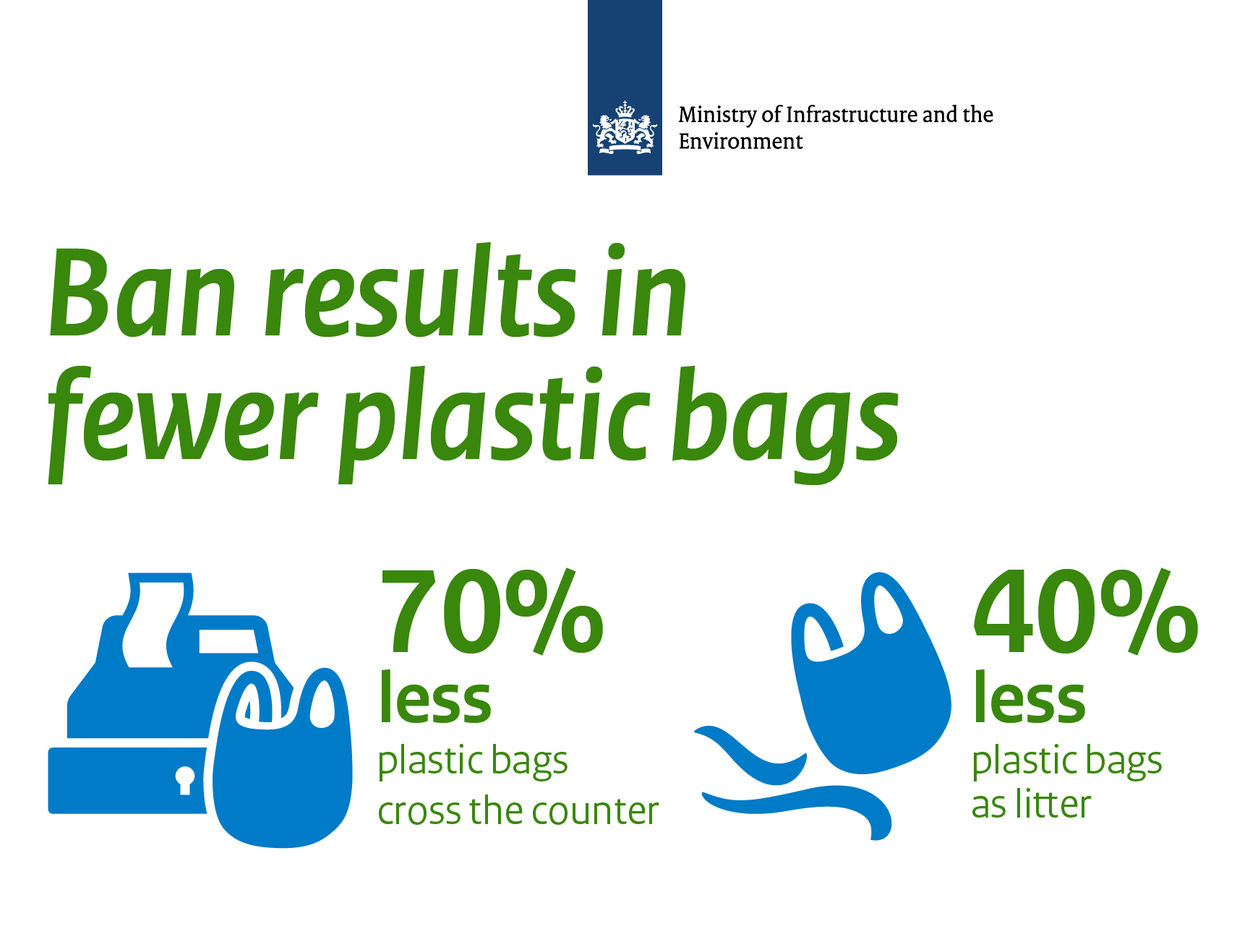
The results a year after the implementation of the Levy. (Government of the Netherlands, 2017)
Responses towards phasing out plastics in the EU:
Plastic is already prevalent in textiles and the manufacturing of tires; however, the immediate and visual destruction and pollution plastic bags push it higher up on the phasing out list. Single-use bags often consist of one type of plastic, commonly polyethene, and many alternative carrier bags are available; thus, regulation of plastic bags are less convoluted (Nielsen et al., 2019). Various forms of rules on the plastic bags were created, ranging from bans and levies to agreements on providing information about the environmental impact of the use (Leeuw, 2020). In addition to this, non-state initiatives were imposed, which assisted spreading the public policies such as voluntary agreements, public service campaigns and extended producer responsibility (Nielsen et al., 2019).
The map below displays, the worldwide update of August 2018 in terms of their plastic bag policies. It can be seen that in Europe, almost all countries have a policy concerning plastic bags; this is due to the EU directive on lightweight plastic bags 2015/720. This directive is the first intergovernmental policy measure that puts restraints on the use of plastic (European Parliament and the Council, 2015).
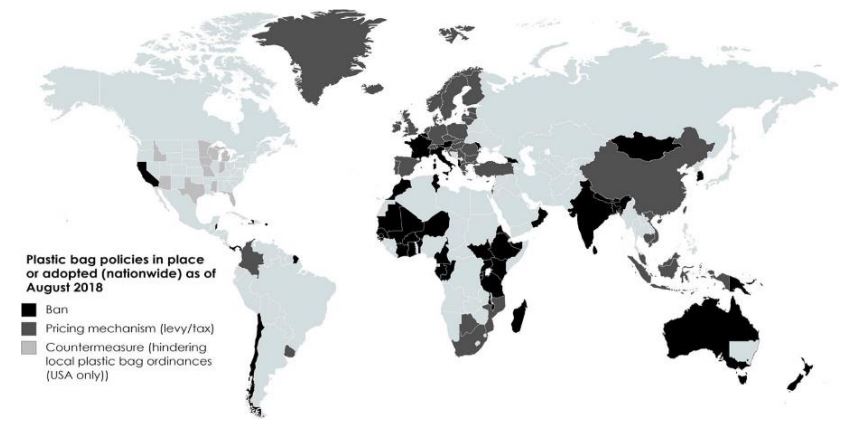
Plastic carrier bag governmental initiatives. Source: Nielsen et al. (2019).
Outcomes of different regulations in the EU:
Statistics on the outcome of various plastic bag regulations are shown in the table below (Nielsen et al., 2019). This table shows the country, policy type and effect of the different policy type. Even though, banning of plastic bags is the most recurrently used policy across the less information is available about the outcome of the ban. This is due to a lack of accurate figures on single-use bag production, plastic waste, waste collection and recycling rates (Nielsen et al., 2019; Knoblauch et al., 2018). Furthermore, an exact number for the possible long-term result of plastic bag levies are unavailable. In Ireland, a long term impact can be observed after the introduction of a levy. The plastic bag use fell to 90%, from 328 plastic bags per person per year to 21 bags. But after six years, the yearly bag use increased to 31 pieces per person (Leeuw, 2020).
After this surge, it was decided to increase the price paid from 0,15cents to 0,22cents per bag (Wagner, 2017). The ban or levies on plastic bags can also cause rebound effects linked to the purchase of other types of plastic bags. In Portugal, a levy showed a reduction to 74%, but simultaneously, the increase of reusable plastic bags was estimated to be 61%, and the consumption of garbage bags showed a rise of 12% (Martinho, Balaia & Pires 2017). This increase of reusable plastic bags and garbage bags is the rebound effect as plastic bags are normally used as a garbage bag after use.
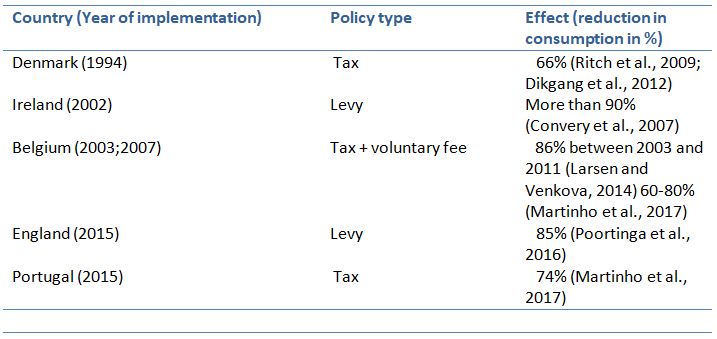
The effectiveness of plastic bag policies in EU countries. Source: Nielsen et al. (2019)
Unfortunately, policy options also raise some problems as it is tough to regulate what should be the price of the bags without people with different income being affected unfairly. Moreover, for the bans, no worldwide consensus exists for which plastic bags the ban holds. In France and Italy, they decided not to include biodegradable plastic bags in their prohibition. There is also no consensus between the thicknesses of the plastic bags. The EU Directive, the focus is on bags between 15 – 50 mm. Bags thinner than this range are excluded for the hygienic purpose of primary packaging of products. Bags which are thicker than 50 mm are excluded as they classify as multi-use bags (European Parliament and the Council, 2015).
Recommendations:
A decrease in the purchase of plastic bags does not outweigh the increase in environmental impact due to the shift from plastic bags to multi-use carrier bags. The best-case scenario is where not only plastic bags are banned, but single-use paper bags are banned as well. This will have the highest decrease in the purchase of bags and the lowest environmental impact (Leeuw, 2020). If a ban on plastic bags is implemented, it would be sufficient that paper bags are banned as well, since they have a high environmental impact. Additionally, carrier and multi-use bags should never be offered for free, since this leads to overconsumption.
References:
European Parliament and the Council. (2015). Directive (EU) 2015/720 of the European Parliament and of the Council of 29 April 2015 amending Directive 94/62/EC as regards reducing the consumption of lightweight plastic carrier bags
Hardesty, B. D., Good, T. P., & Wilcox, C. (2015). Novel methods, new results and science-based solutions to tackle marine debris impacts on wildlife. Ocean & Coastal Management, 115, 4-9.
Knoblauch, D., Mederake, L., & Stein, U. (2018). Developing countries in the lead—what drives the diffusion of plastic bag policies?. Sustainability, 10(6), 1994
Leeuw, S.F.D (2020) Environmental impact of banning plastic carrier bags in the city of Utrecht. Utrecht University
Mansveld, W. (2015, 26 February). Aanpak Draagtassen (o.a. gratis plastic tassen). Retrieved from: https://www.tweedekamer.nl/kamerstukken/brieven_regering/detail?id=2015Z03471&did=2015D0 7153 [9-7-2019]
Martinho, G., Balaia, N., & Pires, A. (2017). The Portuguese plastic carrier bag tax: The effects on consumers’ behavior. Waste management, 61, 3-12.
Nielsen, T. D., Holmberg, K., & Stripple, J. (2019). Need a bag? A review of public policies on plastic carrier bags–Where, how and to what effect?. Waste management, 87, 428-440.
Rijksoverheid. (2019a). Verbod op gratis plastic tassen. Retrieved from: https://www.rijksoverheid.nl/onderwerpen/afval/verbod-op-gratis-plastic-tassen [12-7-19]
Rijksoverheid. (2019b). Wat betekent het verbod op gratis plastic tassen voor consumenten? https://www.rijksoverheid.nl/onderwerpen/afval/vraag-en-antwoord/verbod-op-gratis-plastictassen-consumenten [5-9-2019]
Steensgaard, I. M., Syberg, K., Rist, S., Hartmann, N. B., Boldrin, A., & Hansen, S. F. (2017). From macro-to microplastics-Analysis of EU regulation along the life cycle of plastic bags. Environmental Pollution, 224, 289-299.
Wagner, T. P. (2017). Reducing single-use plastic shopping bags in the USA. Waste management, 70, 3-12.
Warner, B. M. (2009). Sacking the Culture of Convenience: Regulating Plastic Shopping Bags to Prevent Further Environmental Harm. U. Mem. L. Rev., 40, 645.
Xanthos, D., & Walker, T. R. (2017). International policies to reduce plastic marine pollution from single-use plastics (plastic bags and microbeads): a review. Marine pollution bulletin, 118(1-2), 17-26



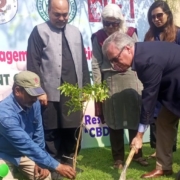



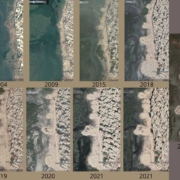




Leave a Reply
Want to join the discussion?Feel free to contribute!